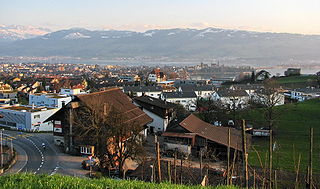
Rapperswil-Jona is a municipality in the Wahlkreis (constituency) of See-Gaster in the canton of St. Gallen in Switzerland. Besides Rapperswil and Jona, which were separate municipalities until 2006, the municipality includes Bollingen, Busskirch, Curtiberg, Kempraten-Lenggis, Wagen, and Wurmsbach.

Rapperswil is a former municipality and since January 2007 part of the municipality of Rapperswil-Jona in the Wahlkreis (constituency) of See-Gaster in the canton of St. Gallen in Switzerland, located at the east side of the Lake Zurich.

Kempraten-Lenggis is a village (Kirchdorf) within the municipality of Rapperswil-Jona, Wahlkreis (constituency) of See-Gaster in the canton of St. Gallen in Switzerland. The remains of the Gallo-Roman settlement Centum Prata are one of the most important archaeological sites in the canton of St. Gallen; Centrum Prata is located at the so-called Kempratnerbucht, in Rapperswil and Busskirch on Zürichsee lake shore.

Rapperswil Castle is a castle, built in the early 13th century AD by the House of Rapperswil in the former independent city of Rapperswil.
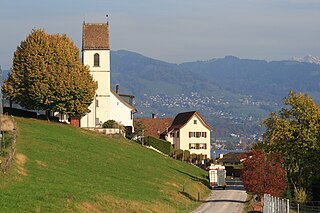
Bollingen is a village (Kirchdorf) within the Swiss municipality of Rapperswil-Jona in the canton of St. Gallen.

Busskirch is a village (Kirchdorf) within the municipality of Rapperswil-Jona in the canton of St. Gallen, Switzerland.

Heilig Hüsli is a bridge chapel in Rapperswil, Canton of St. Gallen, Switzerland.

Rathaus Rapperswil is the former Rathaus of the city government of medieval town of Rapperswil, Canton of St. Gallen in Switzerland. Today, the building houses a café and restaurant, the city archives and a collection of stained glass windows, silverware and paintings. The building and the city archives are listed in the Swiss inventory of cultural property of national and regional significance.

Rüti Monastery was a former Premonstratensian monastery, founded in 1206 and suppressed in 1525 on occasion of the Reformation in Zürich, situated in the municipality of Rüti in the canton of Zürich, Switzerland. The monastery's church was the final resting place of the Counts of Toggenburg, among them Count Friedrich VII and 13 other members of the Toggenburg family, and other noble families. Between 1206 and 1525, the monastery comprised 14 incorporated churches and the owner of extensive lands and estates at 185 localities.

Stadtpfarrkirche St. Johann is a Roman Catholic parish church in the city of Rapperswil, canton of St. Gallen, Switzerland.

Centum Prata is the name of a Roman Vicus, whose remains are located on the eastern Zürichsee lakeshore in Kempraten, a locality of the municipality Rapperswil-Jona in the canton of St. Gallen in Switzerland. Centum Prata is the most important archaeological site from the Gallo-Roman era in the canton of St. Gallen.

Lindenhof in Rapperswil is a moraine hill and a public square being the historic center of Rapperswil, Switzerland.
Regensberg was a family of counts from the Canton of Zürich in Switzerland. The family had possessions in the medieval Zürichgau from the probably mid-11th century and became extinct in 1331 AD. With the extinction of the male line, the city republic of Zürich laid claim to the Regensberg lands and formed the Herrschaft Regensberg respectively Äussere Vogtei.

Uster Castle is a hill castle which was built probably around 1200 AD by the House of Rapperswil in the Swiss municipality of Uster in the Canton of Zürich. Since 1995 it houses a boarding school.

Liebfrauenkapelle is a chapel in Rapperswil, Canton of St. Gallen, Switzerland, which dates back to the ossuary that was built by the House of Rapperswil around 1253 AD.

Einsiedlerhaus is a historic building with an adjoint garden which is part of the former town wall of the medieval Swiss town of Rapperswil in the Canton of St. Gallen.
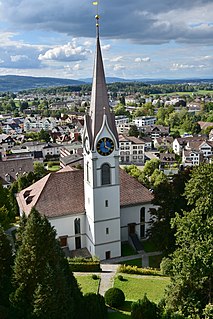
Reformierte Kirche Uster is an Evangelical Reformed church in the Swiss municipality of Uster in the Canton of Zürich that was built in 1824. The predecessor St. Andreas church, situated next to the Uster Castle, was given by the House of Rapperswil and first mentioned in 1099 AD.
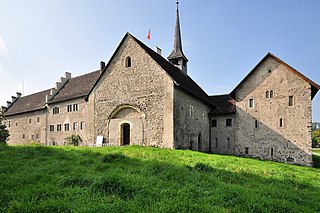
Bubikon Castle or Bubikon Commandery is a castle in the municipality of Bubikon of the Swiss Canton of Zürich. The former Commandery, a medieval monastery of the Knights Hospitaller, is a Swiss heritage site of national significance.
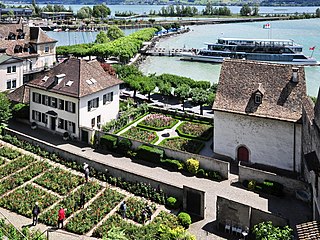
The Rapperswil Rose Gardens are privately established small rose gardens probably dating back to the early years of the former independent town of Rapperswil. They are located in the present city of Rapperswil-Jona, Canton of St. Gallen, in Switzerland.





























